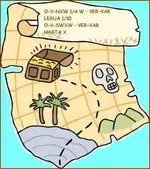The source of the Gasparilla legend
A Juan Gómez, or John Gómez, was a real person who lived in Southwest Florida in the late 19th and very early 20th century. The old man was well known locally for his tall tales of his supposed life as a pirate, and was said to have been the oldest man in the US at the time he died (though this is very unlikely). Gómez is widely speculated to have been the foremost contributor to the development of the Gasparilla legend, although no pre-20th century account of him specifically associate his piratical exploits with José Gaspar, whose story, real or fictitious, does not appear in writing until about 1900, when it was included in an advertising brochure for the Charlotte Harbor and Northern Railroad company.
This brochure was given to the guests of the Boca Grande Hotel situated in Boca Grande, Florida, the largest town on Gasparilla Island. It refers to Old John Gómez's death in 1900 and mentions that Gaspar's massive treasure, hidden somewhere on the island, had never been found. The version of the Gasparilla story told in the pamphlet influenced all later accounts, and served as the inspiration for Tampa's Gasparilla Pirate Festival, first held in 1904.
In 1923, a Boston historian named Francis B. C. Bradlee received a copy of the brochure from the president of Charlotte Harbor and Northern Railroad, and included the story of Gasparilla in a book he was writing about piracy. His book, Piracy In The West Indes And Its Suppression, was used as a source for works such as Philip Gosse's Pirates' Who's Who and Frederick W. Dau's Florida Old and New, the authors of which took Gaspar's historicity for granted. From this point on, historical works about pirates routinely included Gasparilla. At the same time, Tampa's Gasparilla Festival grew more and more elaborate every year; today it attracts thousands of people to the city. In 1980, French anthropologist Andre-Marcel d'Ans exhaustively chronicled the development of the Gasparilla story and the history of the festival in an article for Tampa Bay History.



 IF not then your like the rest, either not wanting someone to find it or not caring. But either way YOU don't KNOW!!!!!!!!
IF not then your like the rest, either not wanting someone to find it or not caring. But either way YOU don't KNOW!!!!!!!!


